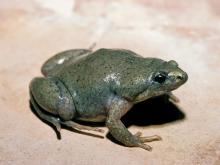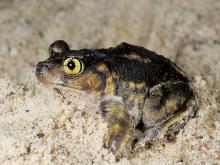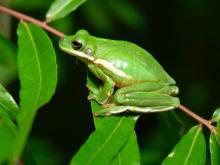Reptiles and Amphibians
Media

Species Types
Scientific Name
Pseudacris maculata
Description
More often heard than seen, the boreal chorus frog calls with a vibrating “prrreeep” that rises in pitch at the end. It lasts one or two seconds and sounds like a fingernail scratched over the teeth of a pocket comb. It occurs nearly statewide, except for the southeastern quarter.
Media

Species Types
Scientific Name
Pseudacris crucifer
Description
The voices of spring peepers are a true announcement that winter is ending. These small, slender frogs can be several overall colors, but seeing an X on the back is a good way to ensure your identification.
Media

Species Types
Scientific Name
Gastrophryne olivacea
Description
The western narrow-mouthed toad has a plump body, short legs, uniform color, small, pointed head, and a fold of skin across the back of the head. The general color is gray, tan, or olive tan. In our state is is reported from far western Missouri and east along the Missouri River as far as the center of the state.
Media

Species Types
Scientific Name
Gastrophryne carolinensis
Description
The eastern narrow-mouthed toad is a plump little amphibian that is seldom seen. There is a fold of skin behind its narrow, pointed head. It occurs in the southern half of the state.
Media

Species Types
Scientific Name
Scaphiopus holbrookii
Description
The eastern spadefoot is a stout, toadlike amphibian with large, protruding eyes, vertically oval pupils, short legs, and large feet. In Missouri, it occurs in eastern counties along the Mississippi River and in the Bootheel.
Media

Species Types
Scientific Name
Anaxyrus cognatus
Description
Unlike other true toads in Missouri, the Great Plains toad has a raised hump between the eyes on the snout. Look for it along the Missouri River floodplain, from the Iowa border to about Hermann.
Media

Species Types
Scientific Name
Anaxyrus fowleri
Description
Fowler's toad is the common toad of gravel and sand bars along our many Ozark streams and rivers. It is also the most common toad in the Bootheel lowlands.
Media

Species Types
Scientific Name
Anaxyrus woodhousii woodhousii
Description
The Rocky Mountain toad has a number of irregular dark brown or black spots on the back and a white belly. It occurs in the Missouri River floodplain, mostly from the central to the far northwestern parts of the state.
Media

Species Types
Scientific Name
Spea bombifrons
Description
The plains spadefoot is a stout, toadlike amphibian with large, protruding eyes, vertically oval pupils, short legs, and large feet. There is a raised area between the eyes. It occurs in counties along the Missouri River.
Media

Species Types
Scientific Name
Hyla cinerea (syn. Dryophytes cinereus)
Description
The bright green treefrog hides perfectly among cattail leaves, where it rests until evening. Then it begins hunting for insects. In Missouri, it occurs mostly in the Bootheel.
See Also
About Reptiles and Amphibians in Missouri
Missouri’s herptiles comprise 43 amphibians and 75 reptiles. Amphibians, including salamanders, toads, and frogs, are vertebrate animals that spend at least part of their life cycle in water. They usually have moist skin, lack scales or claws, and are ectothermal (cold-blooded), so they do not produce their own body heat the way birds and mammals do. Reptiles, including turtles, lizards, and snakes, are also vertebrates, and most are ectothermal, but unlike amphibians, reptiles have dry skin with scales, the ones with legs have claws, and they do not have to live part of their lives in water.





















